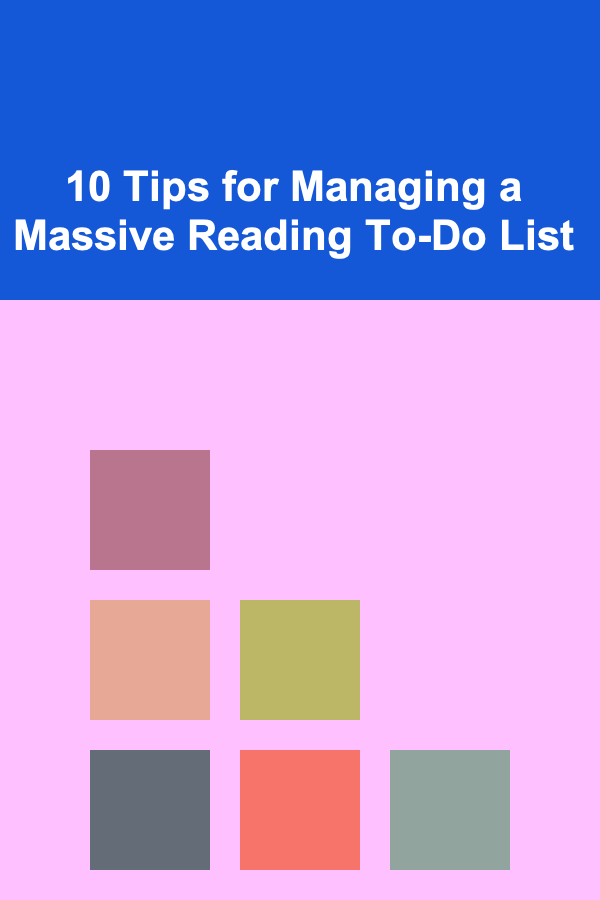
10 Tips for Managing a Massive Reading To-Do List
ebook include PDF & Audio bundle (Micro Guide)
$12.99$11.99
Limited Time Offer! Order within the next:

Managing a massive reading to-do list can feel overwhelming, especially when the list keeps growing faster than you can get through it. Whether you're a student juggling textbooks, a professional trying to keep up with industry trends, or just a book lover with an ever-expanding collection of novels, managing a long reading list requires strategy, discipline, and a bit of patience. Fortunately, with the right approach, you can stay on top of your reading goals and even enjoy the process.
This article provides 10 practical tips for effectively managing your massive reading to-do list. These tips will help you prioritize, stay organized, and read more efficiently, ensuring you make the most out of your time and energy.
Prioritize Your List
One of the first and most important steps in managing a large reading list is to prioritize. Not all books or articles are of equal importance, and trying to read everything at once can lead to burnout.
How to Prioritize:
- Classify by Importance: Separate your list into categories such as "essential," "nice-to-read," and "optional." For instance, textbooks for your studies or research papers for work should be considered essential, while novels and personal development books might fall into the "nice-to-read" category.
- Consider Deadlines: If you have deadlines, such as upcoming exams, project deadlines, or book club meetings, these should take precedence.
- Use the 80/20 Rule: Focus on the 20% of books or resources that will provide you with 80% of the value or knowledge you need. This can help reduce the overwhelming feeling of tackling a never-ending list.
By setting priorities, you can focus on what really matters and ensure that you're making steady progress on your most critical readings.
Break Down Your List into Manageable Goals
Looking at an entire reading list can be daunting. Instead of viewing it as a large, monolithic task, break it down into smaller, more achievable goals.
How to Break It Down:
- Set Specific Daily or Weekly Goals: Rather than saying "I need to read all of this," try setting a goal to read a specific number of pages or chapters per day or week.
- Chunking: If a book is particularly long, divide it into chunks. For instance, commit to reading one chapter per day or a certain number of pages.
- Track Your Progress: Use a checklist, app, or journal to track your reading progress. This visual reminder can be motivating, as it shows you how far you've come.
By breaking the list into smaller chunks, you'll feel more in control and less overwhelmed by the sheer volume of material.
Use Technology to Stay Organized
Managing a massive reading list is much easier when you use the right tools. There are a variety of apps and platforms that can help you organize your to-do list, track your progress, and even make recommendations based on your interests.
Useful Tools:
- Goodreads: This app allows you to organize your reading list, track your progress, and connect with other readers for recommendations.
- Notion or Trello: Both of these tools allow you to create a custom reading board or list, track your goals, and categorize books according to importance.
- Audiobooks and E-Readers: Apps like Audible or Kindle can help you access books on the go, giving you more flexibility to fit reading into your day.
By using technology, you can ensure that your reading list is organized and accessible at all times.
Use a Reading Timer to Stay Focused
In today's world of constant distractions, staying focused while reading can be a challenge. A great way to stay on track is to use a reading timer or adopt time-blocking techniques. The Pomodoro Technique, which involves reading for 25 minutes followed by a 5-minute break, can be highly effective.
How to Use a Reading Timer:
- Set a Timer for Each Session: Rather than reading mindlessly for hours, set a timer for 25--30 minutes of focused reading time. This helps you stay engaged and productive without burning out.
- Take Regular Breaks: After each reading session, take a short break. This prevents fatigue and helps you retain information better.
- Track Sessions: Use a timer app to log how many sessions you've completed. Over time, you'll see a noticeable improvement in your reading output.
By using a timer, you can break up your reading into manageable chunks and stay focused during each session.
Combine Reading with Other Activities
If you're finding it hard to stick to your reading list because of a busy schedule, consider combining reading with other activities. For instance, you can listen to audiobooks while commuting, exercising, or doing household chores.
Ways to Combine Reading with Daily Activities:
- Audiobooks: Audiobooks are a great way to get through books while you're on the go. You can listen during your commute, while cooking, or even while doing chores.
- E-Readers: If you're not fond of carrying physical books, e-readers such as Kindle allow you to read anywhere, making it easy to fit in more reading throughout the day.
- Multitask with Podcasts: If your reading is related to a particular field, you can also listen to podcasts on the same topics. This can supplement your reading without taking up additional time.
By incorporating reading into other activities, you can make more use of your day and get through more books.
Set Realistic Expectations
It's important to set realistic expectations for yourself when it comes to reading. While it's great to have a long list of books you want to read, trying to tackle too many at once can lead to burnout and frustration.
How to Set Realistic Expectations:
- Don't Overcommit: It's easy to become overzealous and set a reading goal that's too ambitious. Instead of trying to read 100 books in a year, start with more achievable goals.
- Be Kind to Yourself: Sometimes life gets in the way of your reading goals, and that's okay. Don't stress over missed sessions or books that take longer than expected.
- Adjust as Needed: If your list becomes overwhelming, consider removing less important items or adjusting your goal to fit your schedule.
Being realistic about your time and energy helps reduce the pressure and ensures that you can enjoy reading without feeling stressed.
Mix Up Your Reading List
If you find yourself losing interest in your massive reading to-do list, try mixing up the genres or types of content you're reading. Alternating between different topics or formats can keep you engaged and prevent burnout.
How to Mix It Up:
- Alternate Genres: If your list is filled with academic books, try adding some fiction, memoirs, or other genres that you enjoy. This creates variety and keeps reading fresh.
- Mix Lengths: Balance long, dense books with shorter reads or articles. This provides a sense of accomplishment and helps keep the momentum going.
- Read for Pleasure and Learning: Don't make all of your reading about productivity or work. Include books that are purely for entertainment to break the monotony.
By mixing up your reading list, you can stay engaged and motivated throughout your journey.
Create a Routine
Establishing a daily or weekly reading routine is key to staying on track with your reading list. Consistency is essential for making meaningful progress.
How to Create a Routine:
- Set a Specific Time: Allocate a specific time each day for reading. Whether it's first thing in the morning or just before bed, having a set time makes reading a habit.
- Make It a Ritual: Create a cozy reading nook with comfortable seating, good lighting, and a cup of tea. This makes your reading time something you look forward to.
- Stay Consistent: Even if it's just for 15--20 minutes, try to read at the same time each day. The consistency will build over time and help you get through your list.
Having a dedicated reading routine ensures that you make steady progress on your list, even if it's just a small amount every day.
Use Your Free Time Wisely
Often, we overlook small pockets of free time throughout the day that could be used for reading. These include waiting for appointments, during your lunch break, or while traveling.
How to Use Free Time:
- Carry a Book or E-Reader: Keep a physical book, tablet, or e-reader with you so that you can read during moments of downtime.
- Use Waiting Time: Instead of scrolling through your phone while waiting for something, try reading a few pages of your current book.
- Listen to Audiobooks: When you're commuting or exercising, listen to audiobooks to make the most of your free time.
By using every free moment to read, you'll see your reading list shrink faster than you might expect.
Reflect and Reevaluate Regularly
As you work through your reading list, it's important to reflect on your progress and adjust your strategy as needed. This allows you to stay flexible and ensure that you're reading books that align with your current interests and goals.
How to Reflect and Reevaluate:
- Assess Your Progress: Regularly check how far you've come and adjust your goals as needed.
- Reevaluate Your List: If you find that a particular book or genre no longer interests you, it's okay to remove it from the list. Life changes, and so do reading preferences.
- Celebrate Milestones: Reward yourself for completing a book or meeting a reading goal. This positive reinforcement keeps you motivated to keep going.
Reflection and reevaluation ensure that your reading list remains enjoyable and aligned with your evolving needs.
Conclusion
Managing a massive reading to-do list doesn't have to be a stressful endeavor. By implementing these 10 tips, you can stay organized, motivated, and focused, making your way through your list one book at a time. Whether you're reading for work, school, or personal growth, these strategies will help you turn a daunting task into a manageable, enjoyable experience.
Remember, the key to success is consistency, flexibility, and knowing when to adjust your goals. So, take a deep breath, dive into your reading list, and enjoy the journey!
Reading More From Our Other Websites
- [Organization Tip 101] Best Lighting Fixtures for Low Vision: Style Meets Functionality
- [Metal Stamping Tip 101] From Prototype to Production: Streamlining Appliance Design with Precision Metal Stamping
- [Tiny Home Living Tip 101] Best Tiny Home Bathroom Solutions: Compact Showers & Smart Storage
- [Home Cleaning 101] How to Clean a Toilet Like a Pro: Eliminating Odors and Stains Effectively
- [Personal Care Tips 101] How to Apply Eyeliner for Beginners: A Comprehensive Guide
- [Organization Tip 101] How to Create a Healthy Snack Station for Pets
- [Personal Care Tips 101] How to Fix Lipstick That Bleeds Outside Your Lip Line
- [Personal Financial Planning 101] How to Create a Personal Budget That Fits Your Lifestyle
- [Home Family Activity 101] How to Ensure Your Family Time Capsule is Durable and Sealed Properly for Long-Term Preservation
- [Organization Tip 101] How to Label Your Sewing Supplies for Better Organization

How to Find Local Home Repair Contractors You Can Trust
Read More
How to Make a Checklist for Creating Compelling Video Content
Read More
How to Manage Inventory for Home Improvement Projects
Read More
How To Use Video Sliders for Product Shots: A Comprehensive Guide
Read More
How To Become a Personal Chef: A Comprehensive Guide
Read More
How to Track Home Office Expenses Legally
Read MoreOther Products

How to Find Local Home Repair Contractors You Can Trust
Read More
How to Make a Checklist for Creating Compelling Video Content
Read More
How to Manage Inventory for Home Improvement Projects
Read More
How To Use Video Sliders for Product Shots: A Comprehensive Guide
Read More
How To Become a Personal Chef: A Comprehensive Guide
Read More